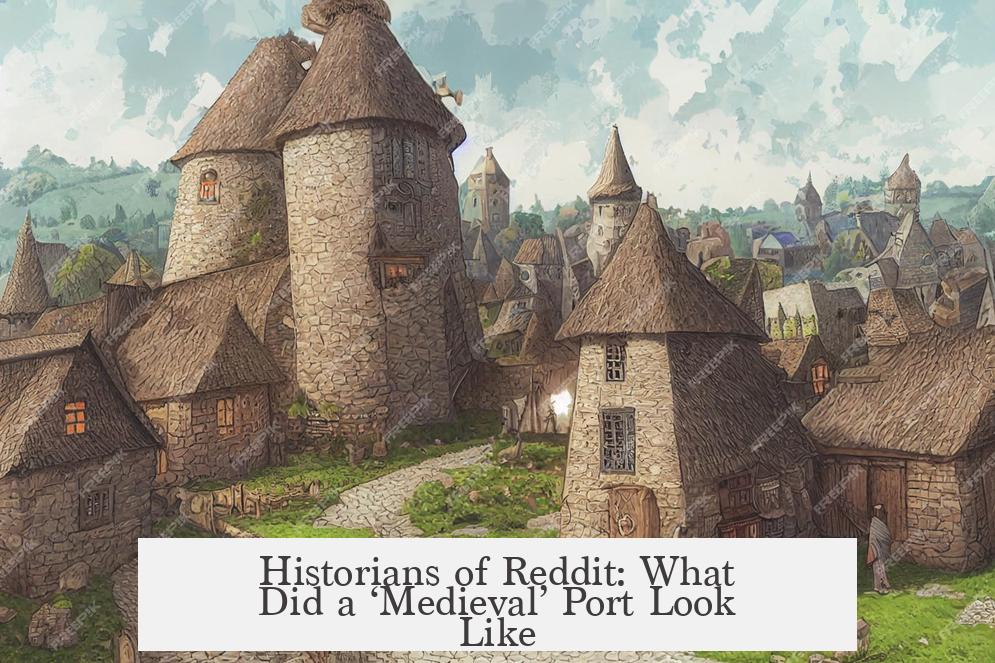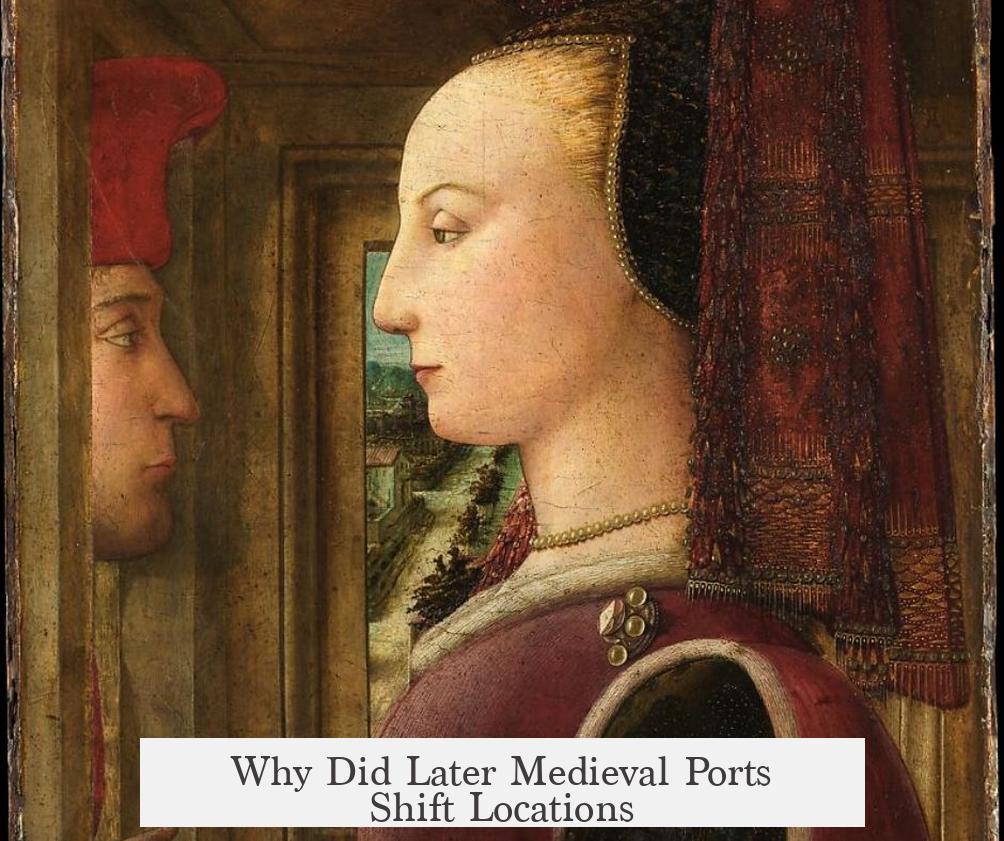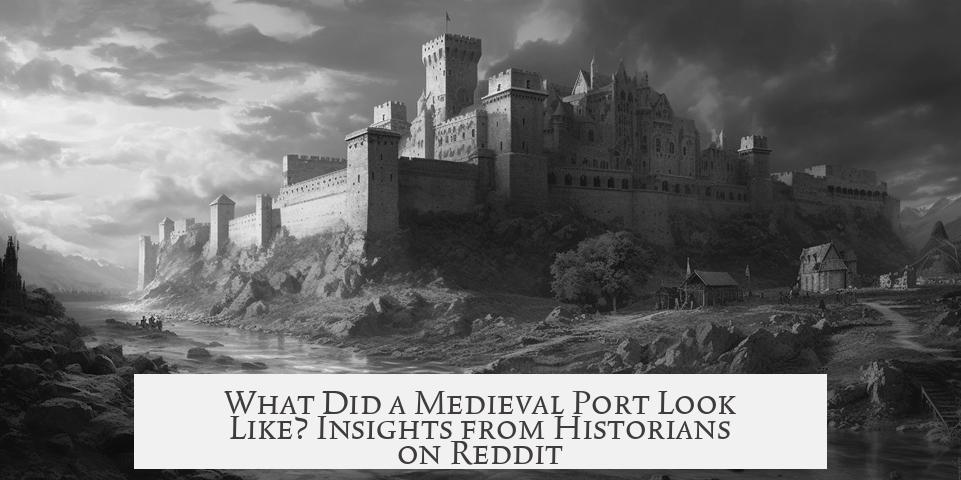A medieval port typically consisted of natural or constructed features designed to accommodate trading ships, customs functions, ship maintenance, and provisions. It combined practical infrastructure with commercial and administrative roles, shaped by local geography and evolving maritime technology.
Many early medieval ports developed inland along rivers or estuaries to avoid sedimentation and manage draft limits for ships. Over time, as vessels grew larger, maintaining deep, accessible waterways became a challenge. For example, the decline of Brugge, a major late medieval port, partly resulted from sediment buildup hindering navigation, despite advances such as wooden crane works for unloading goods.
A well-documented example is the modest but vital medieval port of Palos, located in a natural arm of the river Tinto, near the firth of Huelva, southern Spain. This site provided a naturally deep harbor suitable for caravels and carracks undertaking Atlantic voyages, eliminating the need for constructed docks. Palos supported prominent explorers like the Pinzón brothers, instrumental in Columbus’s 1492 voyage.
| Feature | Description |
|---|---|
| Location | Natural deep river arm fitting large ships; no artificial docks required |
| Main Building | Divided into the alota (customs office for declaring, taxing, and storing goods), a tavern for merchants’ meetings, and the alfar housing lime-processing ovens plus ovens for tiles and bread |
| Water Supply | Nearby spring-fed fountain (La Fontanilla) providing fresh water for ships and locals |
| Shipyard | Wooden structures for shipbuilding and repairs, now lost to time |
| Function | Customs processing, merchant negotiation, ship maintenance, and provisioning |
| Economic Role | Supported major voyages and naval actions, including engagements near the Canary Islands and Galicia |
The main building served as a multifunctional hub. Customs officers inspected and levied taxes there. The adjoining tavern functioned as a meeting place for traders and a waiting area for crews. The ovens were essential for processing lime—needed for construction—and producing tiles and bread, supporting both infrastructure and daily life.
Freshwater access was critical. The Fontaine La Fontanilla, sourced from a spring, stood near the main complex. This ensured seafarers and their ships had reliable water, vital for long voyages and port activities. The port’s proximity to natural water allowed a sustainable supply system uncommon in some coastal ports.
Shipbuilding took place in shipyards close to the port, although mostly wooden constructions meant that remnants rarely survive. Historians rely on documents and archaeological excavations, such as the ongoing work by the University of Huelva, which investigates Palos’ post-landslide remains. Visual reconstructions and 17th-century maps give insights into layout and function.
Comparatively, northern European ports like Brugge featured more complex engineering. Brugge’s canals facilitated transport within the city, while wooden cranes eased cargo handling. These facilities demonstrate the increasing sophistication of port infrastructure in response to larger ships and growing trade volumes.
Reddit historians discussing medieval ports highlight the challenges of sedimentation in port development and underscore the diversity in port layouts across regions. They suggest that early medieval ports often evolved naturally along protected waterways, whereas later medieval ports invested in infrastructure to support expanding economic roles. Sources include documentaries like “Van Eyck in Bruges,” 3D virtual reconstructions, and various scholarly posts on medieval maritime logistics.
In brief, a medieval port like Palos combined natural geography with tailored structures: deep river arms or harbors, customs buildings, merchant halls, lime and tile processing ovens, freshwater fountains, and nearby shipyards. These features supported economic activity, maritime expeditions, and naval defense. Larger ports incorporated cranes, docks, and canals to handle heavier loads, highlighting evolving medieval maritime commerce.
- Medieval ports adapted to geographic conditions—river arms, estuaries, or sheltered coastal sites commonly served as locations.
- Main structures included customs offices, merchant meeting spaces, processing furnaces, and freshwater sources.
- Shipyards near ports usually consisted of wooden facilities, hard to preserve archaeologically.
- Larger medieval ports developed advanced infrastructure like canals and cranes to manage increased ship size and cargo.
- Archaeological finds and documentary sources provide key details about port layouts, functions, and economic roles.
Historians of Reddit: What Did a ‘Medieval’ Port Look Like?

So, what did a medieval port look like? The snapshot changes, depending on time, place, and tech. But generally, these ports balanced natural geography with clever engineering and bustling commerce. Medieval ports weren’t just docks; they were microcosms of trade, administration, and community life. Let’s unfold this fascinating world with insights from historians of Reddit and archaeological findings.
Ever wondered why many early medieval ports developed somewhat inland instead of right on the coast? The answer revolves around sedimentation issues. As ships got bigger and bulkier, their drafts (the depth of water a ship needs to float) deepened, and coastal harbors often silted up quickly. Navigating or docking there became tricky. Picture a port where mud and sand slowly choke the harbor, turning a once-bustling quay into a shallow pond—less than ideal for merchants trying to unload spices, cloth, or barrels of salted fish.
Take Brugge in the later Middle Ages as a shining example of adapting to such challenges. As ships grew in size, it struggled with sedimentation, which partly explains why its prominence faded by the period’s end. Luckily, Brugge had an impressive network of canals, enhancing connectivity inland, akin to medieval Venice. Wooden cranes (yes, cranes!) operated at the quaysides to unload goods. Imagine the cacophony of ships docking, merchants shouting deals, and cargo being hoisted—all streamlined to handle hefty trade goods efficiently. The presence of wooden crane works might seem rudimentary now, but back then, it was quite the innovation.
Medieval Port Infrastructure: More Than Just a Pier
Medieval ports were hubs that combined commercial, administrative, and logistical functions. They often featured a large main building divided into key parts. Customs offices (known as the Alota) played a crucial role in inspecting, declaring, and taxing merchandise. It’s the medieval equivalent of that customs checkpoint you dread at airports, except with salt and silk instead of souvenirs and snacks.
Adjacent to customs, a tavern served merchants as a meeting point and waiting room. This dual-purpose space wasn’t just for sipping ale; it doubled as a negotiation hall for wheeling and dealing. Also tucked within these structures were ovens or furnaces (Alfar) used to process lime for construction, make roof tiles, and yes, even bake bread—the essential fuel for hardworking sailors.
Ports required fresh water, too. At Palos, Andalucía—a modest yet historically significant port—there was a central fountain called La Fontanilla. Fed by a natural spring, it supplied fresh water to ships preparing for epic voyages. Think of it as the medieval equivalent of a gas station but for refilling the lifeblood of ships instead of fuel tanks.
Spotlight on Palos de la Frontera: A Case Study
Palos sits on an arm of the River Tinto in southern Spain’s firth of Huelva. Unlike many medieval ports struggling with sediment, Palos benefited from naturally deep waters needing no dock construction. This fact alone made it perfect for caravels and carracks—vessels built for Atlantic navigation.
What makes Palos special? It’s the departure port for Columbus’ 1492 voyage. Skilled navigators like the Pinzón brothers hailed from this village. These seafarers were vital collaborators whose expertise ensured success beyond mere royal patronage. Their knowledge of currents, wind, and ship handling was critical in a time when ocean-crossing was still an adventure fraught with danger.
| Palos Port Feature | Description |
|---|---|
| Location | Natural river arm with adequate depth, no docks needed |
| Main Building | Alota (customs), tavern (merchant hall), alfar (lime and bread ovens) |
| Water Supply | La Fontanilla fountain, sourced from a natural spring |
| Shipyard | Nearby wooden structures, now lost to time |
| Function | Trade customs, merchant interactions, ship maintenance |
| Historical Importance | Launching point of Columbus’ expedition, hub of skilled sailors |
Archaeological digs by the University of Huelva continue to unearth secrets buried since a 16th-century landslide swallowed parts of the port. Visual aids, like a 17th-century map by Pedro Teixeira and video reconstructions by local researchers, vividly illustrate Palos’ medieval layout. Interested readers can explore these fascinating resources online.
Why Did Later Medieval Ports Shift Locations?

It wasn’t random. Increasing ship sizes pushed ports farther from the coast to avoid sediment-choked channels. This trend influenced design choices profoundly. Additionally, ports started installing wooden cranes to help unload heavier cargo. These infrastructural innovations show medieval society adapting pragmatically to growing economic scales.
Compare this to the Mediterranean ports, which had different challenges and topographies. Reddit historians often discuss these variations. Each port reflects a blend of natural constraints and human ingenuity crafted to keep trade flowing amid shifting sands and tides.
Quiz Time: Can You Imagine?
- What challenges do you think port officials faced when collecting customs fees without modern accounting?
- Could you negotiate deals effectively in a tavern that doubled as customs office waiting room?
- How might the smell of lime kilns, fresh bread, and salty sea air mix in a bustling medieval harbor?
Such questions remind us that medieval ports weren’t quiet, orderly spaces but lively intersections of commerce, regulation, and community life.
Final Thoughts
Medieval ports varied geographically and functionally. Inland ports rose mainly to combat coastal sedimentation. Coastal ports like Palos thrived when natural deep waters allowed larger ships to dock without added infrastructure. Buildings served multiple roles: customs inspection, merchant negotiation halls, lime processing, and ship provisioning. Fresh water was essential, with fountains supplied by natural springs supporting sailors’ needs.
Often, shipyards were nearby but left no trace as wooden constructions succumbed to time. Still, archaeological digs, period maps, and reconstructions illuminate these hubs vividly. Ship sizes, economic shifts, and technological developments continually shaped port layouts over the Middle Ages. This context helps us appreciate maritime commerce’s complexity centuries before container ships and cranes.
If you want to dive deeper, check out the AskHistorians Reddit threads about medieval ports or the documentary Van Eyck in Bruges: Brugge, Europese handelsmetropool in de 15de eeuw. Watching a 3D reconstruction of Het Kraanplein in Brugge in 1562 really brings the medieval waterfront to life.
So, next time you stroll along a modern harbor, imagine the layers beneath: the medieval ports filled with intrigue, commerce, craftsmanship, and the occasional toasted mug of ale after a hard day’s work unloading lime and negotiating cargo deals. Those ports were alive, bustling, and the beating heart of an era long past but never forgotten.
What structures made up a typical medieval port like Palos?
Typically, the port had a main building with customs offices called the alota, a tavern where merchants met, and an alfar—ovens for lime, tiles, and bread. It also featured a central fountain for fresh water. A wooden shipyard was nearby but often not preserved.
How did natural geography affect medieval port design?
Many ports like Palos used natural deep river arms or inlets, avoiding the need for docks. This allowed the accommodation of large ships. Sedimentation was a major challenge later, especially as ships grew in size, causing some ports to decline or relocate inland.
What role did the customs building play at a medieval port?
The customs building was crucial. Merchants declared, inspected, and paid taxes on goods there. It also served as a meeting place for trade negotiations. This structure was the administration center managing port activity and merchandise flow.
Why do some medieval ports have few visible remains today?
Many port structures, especially shipyards, were built from wood and have decayed over time. For example, Palos’ shipyard has not been found due to its wooden construction. Sedimentation and natural events also erased some port features.
How did medieval ports handle water supply for ships and people?
Ports like Palos had a central fountain supplied by a natural spring. This ensured fresh water for ships and dockworkers. Such water points were essential, located close to the main port buildings for easy access during ship provisioning.
What evidence helps historians understand medieval ports today?
Archaeological digs, historical maps, documentary films, and digital reconstructions provide insight. Research on Palos and Brugge, including 3D models and studies of canal networks or crane works, reveal port layouts, infrastructure, and daily functions.




